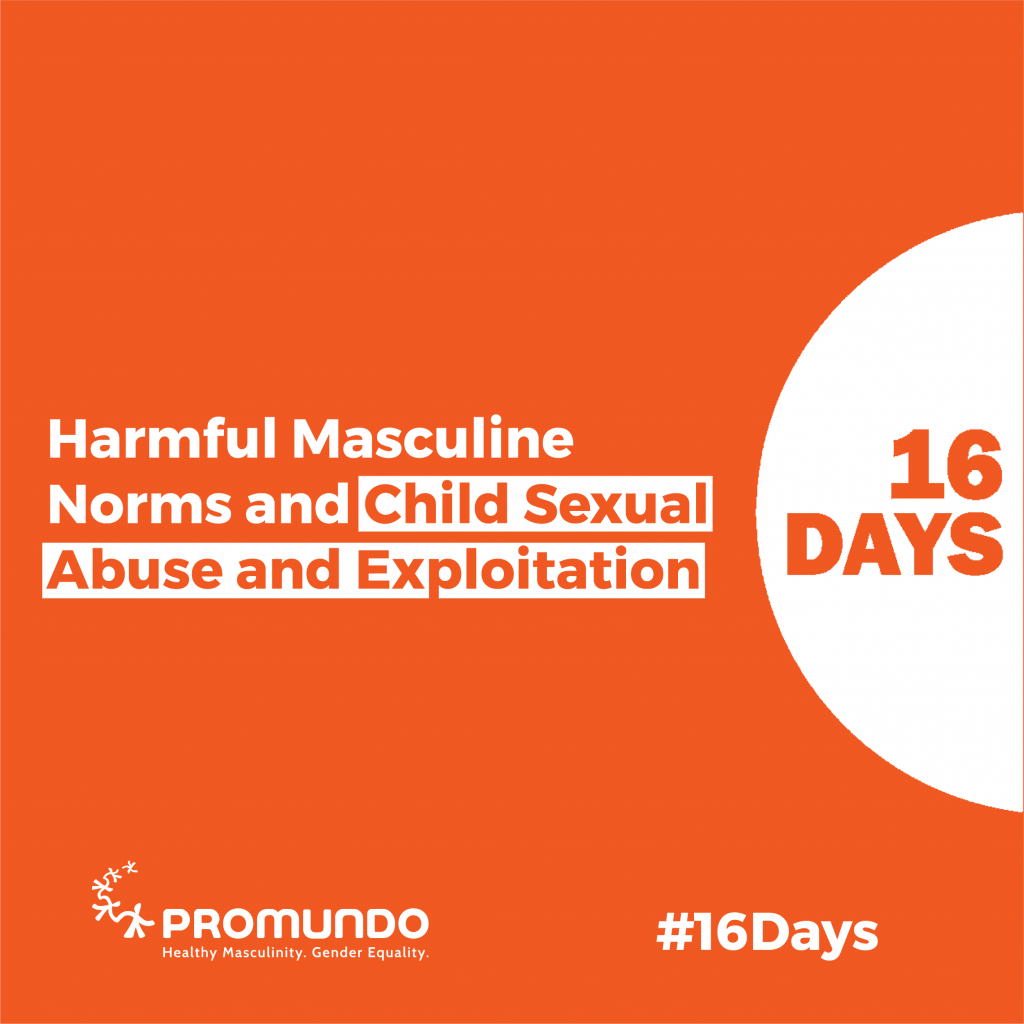Los 16 Días de activismo contra la violencia de género es una campaña internacional utilizada por activistas de todo el mundo (del 25 de noviembre al 10 de diciembre) como estrategia organizativa para pedir la eliminación de todas las formas de violencia de género.
Este año, compartiremos nuestra investigación sobre los vínculos entre las normas masculinas dañinas y ocho formas diferentes de comportamiento violento, así como conocimientos y recomendaciones para eliminar todas las formas de violencia.

Si bien no hay nada inherente al hecho de ser hombre que impulse la violencia, la forma en que socializamos a los niños en sus identidades como hombres y lo que esperamos de ellos (es decir, las normas masculinas de la sociedad) están innegablemente vinculados con la violencia.
De hecho, a menudo se cría, socializa y anima a los niños y a los hombres a usar la violencia de alguna forma; en general, los hombres y los niños tienen una probabilidad desproporcionada de perpetrar la mayoría de las formas de violencia y de morir por homicidio y suicidio. Sin embargo, la investigación afirma que esta violencia es prevenible, la igualdad de género es alcanzable y las normas e ideas no violentas sobre la masculinidad son prevalentes y poderosas.
Informe de la Fundación Equimundo y Oak Normas masculinas y violencia: estableciendo conexiones, examina los vínculos entre las normas masculinas nocivas y ocho formas de comportamiento violento. Este tercer blog de la... Estableciendo las conexiones, 16 días de activismo Esta serie se centra en el abuso y la explotación sexual infantil. Analiza la realidad sobre este problema, explora sus vínculos con otras formas de violencia y ofrece recomendaciones para la acción.
Abuso y explotación sexual infantil
Los hechos
El abuso sexual infantil y la explotación sexual infantil son fenómenos distintos con patrones distintos de prevalencia en todo el mundo, y hay desacuerdo entre los académicos sobre las superposiciones y distinciones en las causas subyacentes a la perpetración.
Son raras las estimaciones rigurosas en varios países sobre la incidencia y prevalencia del abuso sexual infantil, pero todos los datos apuntan al enorme alcance de esta violencia y al hecho de que los perpetradores son abrumadoramente hombres.
La Organización Internacional del Trabajo estima que 1,8 millones de niños en todo el mundo son explotados sexualmente cada año.
Los enlaces
Dada la preponderancia de la evidencia de que la perpetración de abuso sexual infantil es una conducta casi exclusivamente masculina, la investigación sobre las normas de género y las normas masculinas como causa fundamental de esta violencia es bastante limitada. Quienes investigan el abuso sexual infantil con frecuencia discuten las condiciones sociales y los "ecosistemas sociales" que moldean, promueven o restringen las conductas de abuso sexual contra menores. Gran parte de la literatura sobre abuso sexual también señala la "orientación antisocial" o el "comportamiento antisocial" como un importante predictor de agresión sexual y reincidencia entre los agresores previos. Sin embargo, muchas características citadas como factores que aumentan el riesgo de perpetración se asemejan a las normas masculinas nocivas analizadas en este informe, como la impulsividad, las peleas y el consumo excesivo de alcohol.
Las normas de género que asocian la masculinidad con la destreza heterosexual y con el acceso y control sobre los cuerpos de mujeres, niñas, niños y personas de todas las identidades de género también contribuyen a la perpetración masculina de la explotación sexual. La trata de personas, y específicamente la explotación sexual infantil (generalmente niñas en la mayoría de los entornos, pero predominantemente niños en algunos contextos de Asia Central), también está relacionada con las normas masculinas. Un elemento central de estos procesos es la estricta regulación de la vida sexual de mujeres y niñas y la simultánea hipersexualización de sus cuerpos desde una edad temprana.
Las intersecciones
Factores sociales como las normas masculinas interactúan con factores evolutivos, biológicos y situacionales que sustentan la perpetración de abuso sexual infantil. Los patrones y la perpetración de abuso sexual infantil representan una importante oportunidad para aplicar una perspectiva de género, en particular un enfoque en las normas masculinas, en futuras investigaciones. Además, cualquier comprensión de las causas fundamentales de la explotación sexual infantil debe ir más allá del traficante o consumidor individual de sexo, ya que la aceptación social más amplia de la trata y la explotación sexual también influye. Es importante destacar que el abuso sexual infantil involucra, en la gran mayoría de los casos, a perpetradores que son familiares o conocidos de la víctima.
Los efectos generacionales de las experiencias de abuso sexual en la infancia también son claros: la incidencia de agresiones sexuales en la infancia de los perpetradores suele ser significativamente mayor que en la población general.
De la teoría a la práctica
Es poco común que el trabajo centrado en la prevención del abuso y la explotación sexual infantil incorpore enfoques que cuestionen y busquen cambiar las normas de género nocivas, abordando específicamente las masculinidades nocivas. Las iniciativas destinadas a prevenir el abuso y la explotación sexual infantil deben centrarse en las siguientes transformaciones:
- Investigar y deconstruir las formas en que las normas sociales relacionadas con la masculinidad pueden conducir a las mismas tendencias y prácticas antisociales que están vinculadas a la perpetración del abuso sexual infantil.
- Proporcionar educación sobre qué es la explotación sexual infantil y sobre cómo operan dinámicas de poder desiguales en las relaciones íntimas y sexuales entre un adulto y un menor.
- Demostrar los efectos amplios, duraderos y nocivos de la explotación sexual infantil para los niños de todos los géneros e insistir en que nunca está justificada.
- Fomentar el debate y la exploración de masculinidades y sexualidades alternativas que proporcionen ideas saludables y no violentas de la hombría, desvinculadas de la destreza sexual, el dominio y el control.
- Pídales a los participantes que nombren, reconozcan y discutan la naturaleza explotadora del sexo transaccional y cómo las normas de género dañinas informan esta dinámica.
